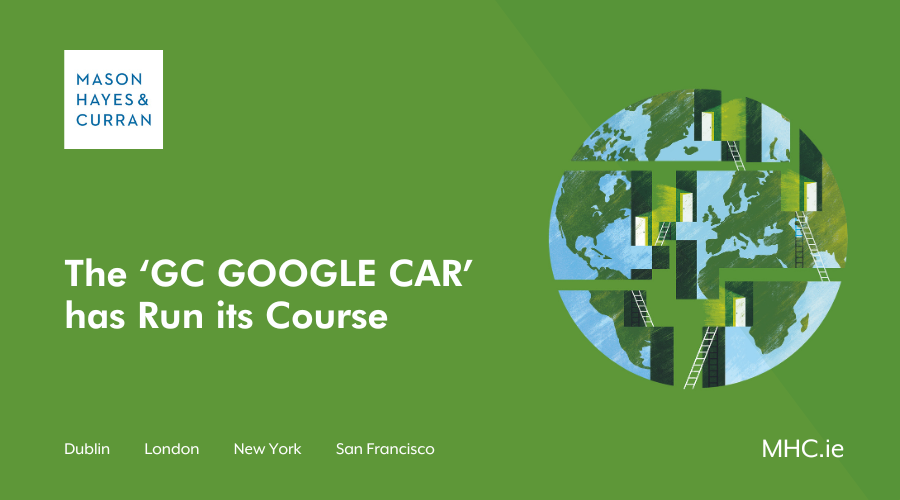
Google is a household name and has become synonymous with searching on the internet. Therefore, it comes as little surprise that the EUIPO’s Opposition Division and a Board of Appeal would reject the registration of the figurative sign for ‘GC GOOGLE CAR’ when it was applied for by Zoubier Harbaou, an individual, for goods in Class 12, namely vehicles and conveyances. Google LLC opposed the registration. In support of its opposition, Google provided a number of its trade marks but notably, none of these were in Class 12.
The Opposition Division
Despite the different classification of goods and services, the Opposition Division refused to register the ‘GC GOOGLE CAR’ trade mark. The Division held that Google’s mark:
- Had been subject to long-standing and intensive use
- Was generally known in the relevant market, and
- Enjoyed a position amongst leading brands
The Division held that the two signs in question were visually and aurally similar in respect of the ‘GOOGLE’ element and that this would be perceived as the main badge of origin. The Division held that there was a conceptual similarity between the two marks as the public would understand the term ‘GOOGLE’ to refer to the famous search engine.
The Division also considered whether the differing goods and services would impact any finding of unfair advantage being taken of Google’s reputation. It considered that vehicles and conveyances, for which the contested mark was seeking registration, were all technological products. It considered that consumers could assume that the vehicles were developed by or in cooperation with Google, incorporated with Google technologies, or operated with tools developed by Google. Therefore, despite the different classification of goods and services, the Division found the contested mark to ride on the coat-tails of Google’s mark.
Appeal
Harbaou appealed, arguing that Google’s marks’ strong reputation could not extend the scope of protection to any other products or services offered by third parties. The goods and services of the two marks were said to be neither complementary nor in competition. Also, as there was no overlap between them, there was no likelihood of confusion. He also argued there was no overlap of the relevant public as those buying vehicles would give a higher degree of attention to goods during purchase. Harbaou argued that ‘GOOGLE’ had no meaning and overall, the signs were dissimilar due to the presence of the other components such as ‘GC’ and ‘CAR’. Additionally, it was pointed out that while Google was already operating in the self-driving car sector, this was under a different name, and it was a project rather than a real commercial activity. Google’s counter argument substantially reiterated the Opposition Division’s findings.
Decision
The Board of Appeal stressed that Google’s mark enjoyed an extremely high level of reputation. The Board noted that Google’s entire mark was incorporated into the contested sign, and this rendered the sign visually similar to an average degree. The two signs were also held to be aurally similar as the pronunciation of ‘GOOGLE’ was identical. Conceptually, the word ‘GOOGLE’ was not held to have any specific meaning, but it was accepted by the Board that the term would generally be associated with Google’s internet search engine or for searching the internet.
Most notably, the Board held that certain marks may acquire a reputation that goes beyond the relevant public as regards the goods and services for which the marks are registered. Google’s mark was found to enjoy a ‘truly global reputation’ and the contested sign was aimed at the public at large, despite Harbaou claiming the goods were aimed at more sophisticated consumers. The Board found that the relevant public of the contested goods would be aware of Google’s reputation and would associate the goods with Google’s mark, perceiving the car as being powered by Google or equipped with Google software.
Overall, the Board found there to be an average level of similarity between the marks and Google’s mark would be exploited if Harbaou was allowed to ride on the coat-tails of Google’s reputation. The appeal was dismissed, and the mark remains unregistered.
Conclusion
This case exemplifies what Article 8(5) of the EUTMR already stipulates; that a trade mark can be refused where it would take unfair advantage of, or be detrimental to, an earlier mark’s reputation, regardless of whether the registration is for the same or different goods and/or services. However, the EUIPO’s stance in this case was clearly impacted by the fact that Google is one of the most renowned companies in the world. Therefore, it is important to remember that when opposing a trade mark on the grounds that it takes unfair advantage of or is detrimental to your brand’s reputation, the outcome of the case will turn on the facts of that case, particularly where the contested mark is for different goods and/or services.
For more information on successfully protecting your organisation’s intellectual property rights, contact a member of our Intellectual Property team.
The content of this article is provided for information purposes only and does not constitute legal or other advice.







